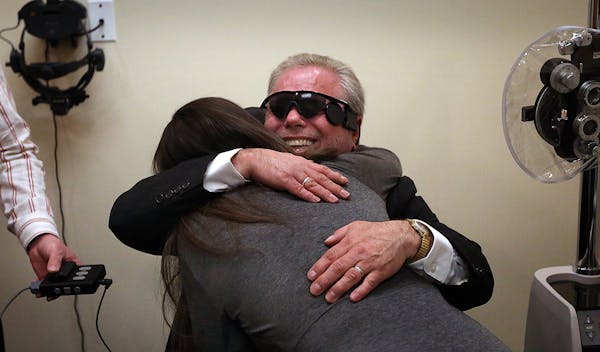The touching moment when a blind Duluth pastor first "saw" his wife, with the help of a bionic eye implant, was recorded by the Star Tribune in March, shortly after a remarkable operation at the University of Minnesota.
Not mentioned was the moment five minutes later, when James Kelm walked out of the exam room at the U Medical Center and tried to point out an elevator door.
"There," he said cautiously, pointing at a plain white wall next to the elevator.
His mistake hardly dampened the March 27 celebration after Kelm became the U's first recipient of the implant, which converts visual information from a camera on Kelm's nose into a cascade of crude lights that his brain interprets. But it showed the long road ahead for the 53-year-old man in terms of figuring out what those images mean, and how to distinguish a door from a wall.
Two months later, it turns out that Kelm was an ideal pioneer, and not just because an incurable condition known as retinitis pigmentosa had slowly turned the eyesight of his youth into an indiscernible charcoal mass. The pragmatic pastor had long ago resolved that he would not get sight back, so he had the patience to tolerate the confusing, sometimes chaotic, lights created by the implant until he could figure out what they mean.
"Since this was a brand new technology and nobody knew what to expect, I … didn't allow myself to have a lot of anticipation or expectation," Kelm said this week. "That's allowed me to be a little bit more patient. As a blind person, you kind of learn some degree of patience, because a lot of things just generally will take longer."
Every other week, he travels with his wife to Minneapolis for tests to hone his understanding of the visual signals. His wife also puts contrasting shapes on a magnetic board at home to test him. "It's kind of like looking into the night sky when you see the stars, all the twinking lights," he said. "Now, I'm learning to recognize the different constellations."
Kelm is an outgoing, guitar-playing leader of True Hope Church in Duluth. The implant, made by California-based Second Sight, hasn't given him new levels of independence yet, but it has made certain routines easier.
Walking a hallway, for example, he recognizes doorways instead of having to search for them with a cane.
When he is preaching or leading a Bible study, he can tell when people leave or arrive. People with wire-rimmed glasses or shiny belt buckles are much easier to spot.
"It's kind of expanding my perception of my surroundings," he said.
The camera feeds visual information to the implant whether his eyes are open or shut, so he takes it off when he needs a rest or the system doesn't offer practical benefit.
"Kind of like reading glasses," he said.
Kelm hopes his experience will advance the technology and improve opportunities for the next generation with his condition: "They will face an entirely different future than I faced."
Two teens wounded, one seriously, in north Minneapolis shooting

How did gambling develop into a major industry in Minnesota?
Myon Burrell arrested on probable cause of narcotics violation
Brooklyn Park community development director departs for Bloomington

